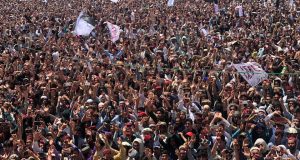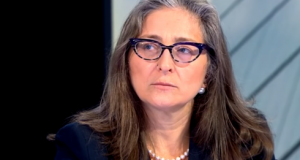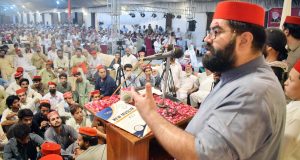 Of late, there has been considerable amount of discussion in various circles of Pakistan on the need of counter extremist narratives for all good reasons. Appreciating the good intentions of all those involved in the process, one would like to underpin essentials for success of such a process. We need to raise and address some fundamental questions. What constitutes a narrative? What kind of narratives dominates the state and society in Pakistan? In other words, what are the state and non-state narratives in Pakistan that influence policy making in political, economic and social domains in Pakistan? How have these narratives been constructed and permeated? Perhaps the most intriguing question in this regard for debate has so far been whether it is possible for non-state organizations to effectively permeate narratives of a discourse without the overt or covert facilitation or support by the state.
Of late, there has been considerable amount of discussion in various circles of Pakistan on the need of counter extremist narratives for all good reasons. Appreciating the good intentions of all those involved in the process, one would like to underpin essentials for success of such a process. We need to raise and address some fundamental questions. What constitutes a narrative? What kind of narratives dominates the state and society in Pakistan? In other words, what are the state and non-state narratives in Pakistan that influence policy making in political, economic and social domains in Pakistan? How have these narratives been constructed and permeated? Perhaps the most intriguing question in this regard for debate has so far been whether it is possible for non-state organizations to effectively permeate narratives of a discourse without the overt or covert facilitation or support by the state.
As is well-known, sustained thought process ingrained in the schemas of an individual and collectivity which is empowering or disempowering for an individual or a group in a society constitute narratives of a discourse. Theoretical domains of epistemology, institutions for the construction of knowledge and organized use of tools for the dissemination of information have been observed to be effective means for the permeation of a particular narrative of a discourse. Over the years, states have garnered ways and means to monopolize knowledge construction and built overwhelming institutional capacity for organized dissemination of information.
One can two observe two pre-dominant narratives constructed as a discourse in Pakistan since its inception. The first narrative consists of a particular rigid and homogenizing interpretation of Islam that brought about religiosity. This religiosity has been used for political legitimacy, concentration of resources and definition of nationhood alike. Marginalization of groups with various religious or sectarian denominations, objectification of women and suppression of dissidence were justified through this pre-dominant narrative.
The second narrative that has been constructed over the years can be termed as nationalist discourse of statehood. A particular interpretation of statehood that supports concentration of power, defines territorial integrity and constructs security paradigm have been enforced over the years in Pakistan. Norms and laws have been put in place that repudiate national identities, exclude cultural and historical entities, distort historical roots of indigenous civilizations, manufacture an isolationist worldview and develop elitist oligarchy. Demonization of democratic political process, strangulation of the voices of the down-trodden and persecution of the movements for indigenous identity and autonomy are justified through this narrative.
It is not that difficult to observe the not so subtle influences of the permeation of these narratives in behavioural patters of the society, state policies and social media. It will not be out of place to pause and reflect on social media for a while.
Interesting strands of opinions are observed while surveying social media in Pakistan. The ones who comment against the Women Protection Bill are also the ones who would like the prime minister to resign after Panama Leaks. The ones who mourned the droning of Mullah Mansour on Pakistani soil are usually the ones who also urge to beat war drums against the west and the US. The ones who demonize politics and politicians are also the ones who celebrate figures of the security establishment on all relevant and irrelevant occasions.
The users of social media who write comments against the democratic dispensation in the country are also usually the ones who glorify ‘Jihad’ in other lands in their posts and comments. Those who seem to believe the whole world is out there to conspire against Islam and Pakistan are usually also the ones who demand implementation of Sharia irrespective of their individual life style. Those who advocate moral policing are also mostly the ones who would try to defame Malala Yousufzai by dubbing her as an ‘agent of the west’.
The profiles of such social media users indicate that they mostly belong to urban middle class with more access to modern technology and information. In all likelihood, they might have been under the direct impact of mainstream media because they have the means to access general and professional educational institutions of average standard. The strands and layers of narratives might seem diverse at a cursory glance but are proven to be closely connected and interlinked when dissected through a deeper level of analytical framework.
The patterns of opinions that constitute collective narratives suggest incisive penetration of constructs pertaining to world view, civilization, politics, society and culture. Besides other factors, the expression of disgust and hatred regarding ‘modern’, ‘mundane’, ‘progress’ and ‘western’ seems to emanate from the core of the world view that life is fleeting, transient and not to be loved. Everything that invalidates this constituent of the worldview shocks and makes angry. The anger then comes out in the shape of denial, blaming and finding conspiracy even if without any grain of logic and rationality. Various ramifications of this worldview proliferate in various socio-cultural layers.
The denial of positive role models and suspicion of democratic dispensation might have come forth from loss of trust in human cognition and human will. This is expressed through the desire for ‘Messiah’ rather than the collective will of a group of people to erect institutions for self-governance. On the one hand, refusal to accept achievement of an individual human, and on the other hand, renunciation of collective human will creates penchant for short-cuts, externalization of responsibility and enamor with a ‘hero’ having supernatural powers to put all things right within a short span of time. This construct naturally leads to repudiation of democratic behavioural pattern and rebuffing of Nobel Laureates among them simultaneously.
Lack of capacity to accommodate diversity also seems to be an offshoot of this construct. How can there be diversity of opinions, faiths, lifestyles and gender role if cognition of a group of people is incapable to grasp, understand and dissect? This seems to have not only led to the all pervasive patriarchal tendencies and objectification of women in the society but also developed an attitude of epistemic certainty. Absolutism of truth and reality and homogenization of all kinds might walk on parallel paths but in the same direction.
This core of the narrative makes observation, inference, and experimentation with diverse objects and ideas irrelevant and sometimes useless. This behavoural pattern creates fascination with the ‘golden past’ than with current and emerging diverse challenges and realities. Besides, control and authority take precedence over creativity, innovation and self-regulation. What else is extremism that might turn into extremist violence with the passage of time?
We need to keep this in mind that pattern of constructs, narratives and the resultant behavoural strands of individuals do not occur just automatically. The process has a subtle but deep rooted correlation with the distribution of power and resources in a society. It cannot be just coincidence that these constructs and narratives are taught through curricula, promoted through socio-political organizations, reinforced through media, glorified through arts and poetry and exalted through drama and theater.
The process of constructing counter narratives has to start with a debate on these subtle and deep-seated constructs. Enacting a few laws and carrying out a few projects on interfaith harmony only might help in the short term but would not enable the society to construct alternative narratives in the long run. Academia, political parties and civil society organizations have to discover various subterranean layers of the militant discourse instead of scratching the surface. The core issues of vertical and horizontal inequities have to be observed in the existing narratives and have to be articulated for constructing alternative narratives.
Finding alternatives to narratives having subtle correlation with distribution of power and resources is a long process. Political will, academic research and mass mobilization simultaneously go into the fermentation of the process. Overhauling curriculum, promoting humanistic cultural traditions and expanding political representation might be prioritized as structural aspects of the process.
By Khadim Hussain
The writer is author of ‘The Militant Discourse’. He tweets @Khadimhussain4
THE PASHTUN TIMES
 Pashtun Times Latest News
Pashtun Times Latest News



